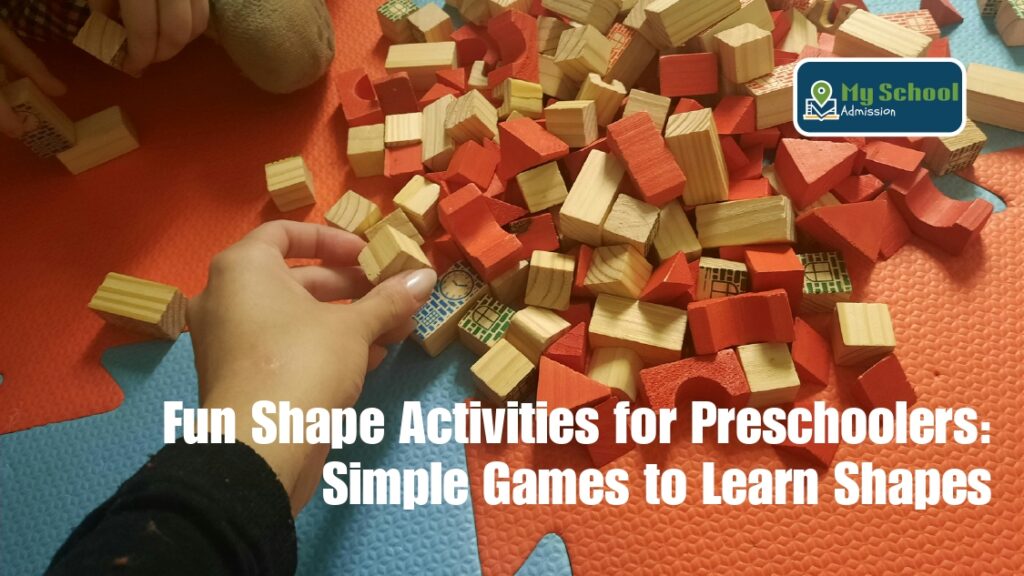The role of shapes plays an important role while building foundational mathematical and cognitive skills. Preschoolers are naturally curious and learn best through play-based activities.
Shapes are not just about recognition, they also are about logical thinking, spatial awareness and creativity.
This blog provides all the information you’ll need about practical, fun shapes activities for kids.
Why Learning a Shape Activity Is Important for Preschoolers:
- Shapes activity for kids are building blocks of early math concepts. For example: Geometry, measurement, symmetry.
- It also builds a solid foundation for Cognitive development by helping children with classification, problem solving and memory.
- Language skills are shown to improve because learning shapes improves vocabulary and communication.
- Real world objects also become more identifiable, because they identify shapes in daily objects. (circle=ball, square=box)
- Learning shapes also supports pre-writing and drawing skills like lines, curves and angles. This prepares kids for letters and numbers.
- It also strengthens Social- emotional aspects like teamwork, sharing and patience.
Simple and Fun Shapes Activity for Kids:
Fun with shape activities is the best kind of fun there is for children. Learning shapes activities can be educational, and help cognitive development.
- Shape Hunt (Scavenger Hunt Style)
- What it is: A playful search game that allows children to look for objects in a specific shape around the classroom, home or playground.
- How to do it:
- Show a flashcard of a shape like a circle, triangle, or a square.
- Ask kids to find the same shape around the room, like a table, door or a ball.
- Why it works:
- Kids connect abstract shapes to real world objects, making learning meaningful and fun.
- Skill developed :
- Observation, logical association, early math vocabulary and real-world awareness.
- Shape Sorting Game
- What it is:
- Sorting and categorizing shapes into groups.
- How to do it:
- Provide cutouts, toys, or blocks of different shapes.
- Ask kids to separate them into boxes or trays of shapes.
- Why it works:
- Sorting strengthens logical reasoning and early math concepts like classification.
- Skills developed:
- Critical thinking, memory, organizing and visual discrimination.
- What it is:
- Shape Hopscotch
- What it is:
- A twist on the traditional hopscotch game using shapes instead of numbers.
- How to do it:
- Draw large shapes on the floor with chalk or tape.
- Call out a shape and children must hop onto it.
- Why it works:
- Combines learning with movement, keeping preschoolers active.
- Skills developed:
- Gross motor skills, balance, listening, quick recall of shape names.
- What it is:
- Shape Collage with Everyday Materials
- What it is:
- A craft based activity where children get to create pictures using cutout shapes.
- How to do it:
- Provide coloured paper, leaves, buttons or pasta.
- Kids assemble a house, car, tree using triangles, rectangles and circles.
- Why it works:
- Encourages creativity while reinforcing shape recognition.
- Skills developed:
- Fine motor skills, imagination, artistic expression, hand eye coordination.
- What it is:
- Shape Flashcard Memory Game
- What it is:
- A card flipping game to test memory and recognition skills.
- How to do it:
- Lay shape flashcards face down.
- Children flip two at a time to find matching pairs.
- Why it works:
- Improves both shape recognition and concentration.
- Skills developed:
- Memory, focus, problem solving and patience.
- What it is:
- Edible Shapes (snack time learning)
- What it is:
- Turning snack time into a shape learning session.
- How to do it:
- Cut sandwiches, fruits or biscuits into triangles, circles and squares.
- Ask kids to identify the shape before eating.
- Why it works:
- Adds a sensory and fun element to learning which makes it memorable.
- Skills developed:
- Sensory learning, real world application and vocabulary.
- What it is:
Tips for parents and teachers
- Start with basic shapes for shapes activities for kids like circles, squares, rectangles and triangles before moving to complex shapes like hexagons and ovals.
- Use repetition in daily routines by pointing out shapes in books, signs and home objects. Which will help in learning shape activities for kids.
- Keep activities short and engaging to match preschoolers attention span while also leaving them wanting more because of its fun characteristics.
- Mix physical, creative and sensory activities for holistic learning. Which will lead to fun with shape activities.
- Encourage group activities to build social skills along with shape knowledge.
- Use positive reinforcement and celebrate even the smallest achievements
Conclusion
Shapes are everywhere and learning them through games makes preschool education enjoyable. For holistic learning with a long list of strengths that can be gained through them, incorporating learning shape activities into daily learning is just a small change that will improve the game.
We at My School Admission, we believe that early playful learning today sets the foundation for future academic success. Need more articles like this that make your life a little easier? Check out our blogpage now!



